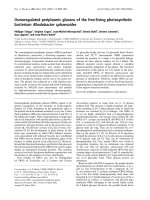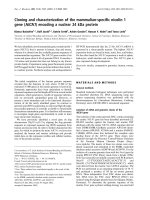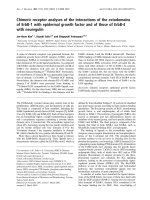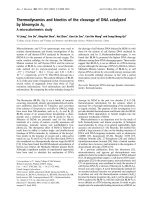Báo cáo y học: "rimary myoepithelial carcinoma of the lung: a rare entity treated with parenchymal sparing resection" ppsx
Bạn đang xem bản rút gọn của tài liệu. Xem và tải ngay bản đầy đủ của tài liệu tại đây (496 KB, 3 trang )
CASE REP O R T Open Access
Primary myoepithelial carcinoma of the lung:
a rare entity treated with parenchymal
sparing resection
Inderpal S Sarkaria
1*
, Deborah DeLair
2
, William D Travis
2
, Raja M Flores
3
Abstract
Primary lung myoepithelial carcinomas are rare neoplasms arising from the salivary glands of the respiratory
epithelium. Given the rare occurrences and reports of these tumors, appropriate recommendations for resection
are difficult to formulate. Although classified as low-grade neoplasms, these tumors have a significant rate of
recurrence and distant metastasis.
Introduction
Primary salivary g land-type tumors of the lung are rare
and include mucoepidermoid carcinoma, adenoid cystic
carcinoma, acinic cell carcinoma, oncocytoma, epithe-
lial-myoepithelial carcinoma, benign myoepithelioma,
and mixed tumors of both benign and malignant nature
[1-16]. Primary pulmonary myoepithelial carcinomas are
exceedingly rare, with only five known prior cases
reported in the English literature to date [17-20]. We
report a case of primary myoepithelial carcinoma of the
lung and a review of the literature.
Case Report
A 63-year-old woman presented to the clinic with a his-
tory of increasing pulmonary congestion, difficulty
expectorating, and low-grade hemoptysis. Her past med-
ical history was significant for diet-controlled insulin-
dependent diabetes mellitus. There was no history of
cigarette or other tobacco use. Her mother had died o f
breast cancer in her fifties. A chest radiograph showed a
large mass in the right lower lung fields, and computed
tomography scanning revealed a 12.4 × 8.3 centimeter
smoothly circumscribed heterogeneous mass arising in
the right minor fissure and impingi ng upon the right
atrium (Figure 1A). A fine needle aspiration was per-
formed which yielded a diagnosis initially suspicious for
schwannoma, as reviewed at an outside institution. At
the time of thoracotomy, dense adhesions were dissected
free of the upper and middle lobes with no evidence of
tumor invasion, and the mass was resected en-bloc with
pericardium and a wedge resection of the lower l obe.
An additional separate lower lobe nodule was also
excised and presumed to be a metastatic focus of tumor.
The patient had an uneventful recovery and was dis-
charged home on post-operative day number three.
The patient developed a biopsy proven solitary liver/
diaphragmatic metastasis diagnosed on routine follow-
up at 36 months post-resection.
Pathologic Findings
Gross pathologic examination revealed the mass to be a
13 × 8 × 8 centimeter lower lobe carcinoma of myoe-
pithelial origin involving the visceral pleura (Figure 1B).
Histologically, the mass was consistent with a malig-
nant myoepithelia l neoplasm with a fibrous capsule and
20% necrosis. The mass was thought to arise from the
right lower lobe and involved the visceral pleura. The
margin was focally within 0.1 cm of the tumor, but
otherwise grossly free of invasion. The separate no dule
was 1 cm in size and histologically similar to the pri-
mary tumor.
Immunohistochemical stains were performed and were
focally positive for AE1/AE3, Bcl2, Cam5.2, S100p,
GFAP,4A4,SMA,andCD99.StainsforEMA,desmin,
CD34, calponin, FLI1, myogenin, and synaptophysin
were negative.
* Correspondence:
1
Department of Surgery, Thoracic Service, Memorial Sloan-Kettering Cancer
Center, 1275 York Avenue, New York, NY, 10065, USA
Full list of author information is available at the end of the article
Sarkaria et al. Journal of Cardiothoracic Surgery 2011, 6:27
/>© 2011 Sarkaria et al; licensee BioMed Central Ltd. This is an Open Acc ess article distributed unde r the terms of the Creative Commons
Attribution License ( which permits unrestricted use, distr ibution, and reproduction in
any medium, provided the original work is properly cited.
Discussion
Myoepithelial carcinomas primarily arise from the sali-
vary glands, the parotid, or the breast [21]. Rarely, they
may arise in soft tissues, most often in the lower and
upper limbs, occurring equally in me n and women [22].
These soft-tissue tumors, distinguished from benign
myoepitheliomas by their moderate or severe cytologic
atypia or invasive growth pattern, recur locally in 42% of
patients and metastasize to distant sites in 32%.
Primary myoepithelial carcin omas of the lung are
exceedingly rare, with only 6 patients reported in the
English literature, including the present report [17-20].
Clinical data from these reports are summarized in
Table 1. Very limited information was available for one
patient [20]. Most patients were male, in their fifth or
sixth decade of life at diagnosis, and smoked tobacco.
Most patients presented with primarily endobronchial
disease, had preoperative biopsies o f their tumors, and
Figure 1 Radiographic and gross pathologic appearance of primary pulmonary myoepithelial carcinoma. A. Computed tomography of
right-sided chest mass with compression of right atrium. B. Gross pathologic appearance of right visceral pleural mass.
Table 1 Clinical characteristics of reported cases of myoepithelial carcinoma of the lung
AUTHOR Age/
Sex
Smoking Location Pre-op Bx
Diagnosis
Size
(cm)
Resection Type Local
Recurrence
Metastasis Outcome
Present case 63F No RLL, Pleural &
parenchymal
Low grade
spindle cell
neoplasm
13.0 Wedge/Local
excision
No Yes, same lobe/
pleura at time of
resection, liver at 36
months
AWD at 36 months
Masuya 2005 48M Yes LLL,
Parenchymal
&
Endobronchial
Sarcoma,
sarcomatoid
carcinoma,
carcinosarcoma
1.5 Lobectomy No No NED 15 months
Miura 2000 46M NA Right hilum,
Right Main
Stem,
Endobronchial
No atypical
cells
6.5 Pneumonectomy No Yes, LLL AWD at 7 months
Higashiyama 58M Yes RUL,
Endobronchial
NA 3.8 Sleeve
bilobectomy
(RUL/RML)
No Yes, soft tissue left
arm and hip
DOC at 14 months
(metastatic
synchronous
adenocarcinoma)
Higashiyama
1998
58M Yes LUL,
Endobronchial
Squamous cell
carcinoma
6.0 Sleeve
lobectomy (LUL)
No Yes, liver DOD, 60 months
Sekine 1998 NA NA NA NA NA NA NA Yes NA
RLL - right lower lobe; LLL - left lower lo be; RUL - right upper lobe; LUL - left upper lobe; RML - right middle lobe; Bx - biopsy; NED - no evidence of disease;
AWD - alive with disease; DOC - dead of other causes; DOD - dead of disease.
Sarkaria et al. Journal of Cardiothoracic Surgery 2011, 6:27
/>Page 2 of 3
underwent anatomic resections of these malignancies.
There were no local recurrences. Almost all patie nts
had metastatic disease, either synchronous at time of
resection, or presenting as metachronous recurrence.
Follow-up was less than two years for all but one
patient, who died of metastatic disease to the liver five
years postoperatively. One other patient died at fourteen
months from sy nchronous metastatic adenocarcinoma.
One patient was alive with disease, and two others were
free of disease at relatively short follow-up intervals.
Given the available reported data, there are a number
of unique characteristics of the current case when com-
pared to the previous five. This case represents the eld-
est and only female patient, as well as the only known
never-smoker. This patient’s tumor is also the greatest
in size within this series, more than doubling the pre-
vious known la rgest of these tumors. All other patients
in the series presented with a major component o f
endobronchial disease, whereas the current tumor was
primarily pleural/parenchymal based. Finally, the current
case represents the only patient treated with a limited
sub-anatomic resection.
Given the relatively high rates of recurrence, low-grade
malignant status, and the propensity for recurrence at dis-
tant sites, it is reasonable to consider limited sub-anatomic,
parenchymal sparing resec tions for these pa tients , espe-
cially if pneumonectomy is contemplated. While this may
not be adequate for endobronchial lesions involving major
pulmonary segments, it is feasible for lesions presenting
with primarily parenchymal or pleural based disease, as in
the current case. Given the rarity of these tumors, recom-
mendations regarding chemotherapy or radiation, either
pre- or postoperatively, are difficult to formulate.
Consent
Written informed consent was obtained from the patient
for publication of this case report and accompanying
images. A copy of the written consent is available for
review by the Editor-in-Chief of this journal.
Author details
1
Department of Surgery, Thoracic Service, Memorial Sloan-Kettering Cancer
Center, 1275 York Avenue, New York, NY, 10065, USA.
2
Department of
Pathology, Memorial Sloan-Kettering Cancer Center, 1275 York Avenue , New
York, NY, 10065, USA.
3
Division of Thoracic Surgery, Mount Sinai Medical
Center, 1190 Fifth Avenue, PO Box 1028, New York, NY, 10029, USA.
Authors’ contributions
ISS performed study design, data collection, and primary manuscript
preparation and revision. DD performed gross, histological, and molecular
pathology review and interpretation. WDS performed study design,
pathology review, and manuscript preparation and revision. RMF performed
study inception, study design, study oversight, and manuscript review and
revision. All authors have read and approved the final manuscript.
Competing interests
The authors declare that they have no competing interests.
Received: 21 October 2010 Accepted: 8 March 2011
Published: 8 March 2011
References
1. Doganay L, Bilgi S, Ozdil A, Yoruk Y, Altaner S, Kutlu K: Epithelial-
myoepithelial carcinoma of the lung. A case report and review of the
literature. Arch Pathol Lab Med 2003, 127:e177-180.
2. Cagirici U, Sayiner A, Inci I, Veral A: Myoepithelioma of the lung. Eur J
Cardiothorac Surg 2000, 17:187-189.
3. Fulford LG, Kamata Y, Okudera K, Dawson A, Corrin B, Sheppard MN,
Ibrahim NB, Nicholson AG: Epithelial-myoepithelial carcinomas of the
bronchus. Am J Surg Pathol 2001, 25:1508-1514.
4. Cho KJ, el-Naggar AK, Ordonez NG, Luna MA, Austin J, Batsakis JG:
Epithelial-myoepithelial carcinoma of salivary glands. A
clinicopathologic, DNA flow cytometric, and immunohistochemical study
of Ki-67 and HER-2/neu oncogene. Am J Clin Pathol 1995, 103:432-437.
5. Davis PW, Briggs JC, Seal RM, Storring FK: Benign and malignant mixed
tumours of the lung. Thorax 1972, 27:657-673.
6. Fechner RE, Bentinck BR, Askew JB Jr: Acinic cell tumor of the lung. A
histologic and ultrastructural study. Cancer 1972, 29:501-508.
7. Horinouchi H, Ishihara T, Kawamura M, Kato R, Kikuchi K, Kobayashi K,
Maenaka Y, Torikata C: Epithelial myoepithelial tumour of the tracheal
gland. J Clin Pathol 1993, 46:185-187.
8. Moran CA, Suster S, Askin FB, Koss MN: Benign and malignant salivary
gland-type mixed tumors of the lung. Clinicopathologic and
immunohistochemical study of eight cases. Cancer 1994, 73:2481-2490.
9. Nistal M, Garcia-Viera M, Martinez-Garcia C, Paniagua R: Epithelial-
myoepithelial tumor of the bronchus. Am J Surg Pathol 1994, 18:421-425.
10. Pelosi G, Fraggetta F, Maffini F, Solli P, Cavallon A, Viale G: Pulmonary
epithelial-myoepithelial tumor of unproven malignant potential: report
of a case and review of the literature. Mod Pathol 2001, 14:521-526.
11. Ryska A, Kerekes Z, Hovorkova E, Barton P: Epithelial-myoepithelial
carcinoma of the bronchus. Pathol Res Pract 1998, 194:431-435, discussion
436-438.
12. Santos-Briz A, Terron J, Sastre R, Romero L, Valle A: Oncocytoma of the
lung. Cancer 1977, 40:1330-1336.
13. Spencer H: Bronchial mucous gland tumours. Virchows Arch A Pathol Anat
Histol 1979, 383:101-115.
14. Strickler JG, Hegstrom J, Thomas MJ, Yousem SA: Myoepithelioma of the
lung. Arch Pathol Lab Med 1987, 111:1082-1085.
15. Tsuji N, Tateishi R, Ishiguro S, Terao T, Higashiyama M:
Adenomyoepithelioma of the lung. Am J Surg Pathol 1995, 19:956-962.
16. Wilson RW, Moran CA: Epithelial-myoepithelial carcinoma of the lung:
immunohistochemical and ultrastructural observations and review of
the literature. Hum Pathol 1997, 28:631-635.
17. Higashiyama M, Kodama K, Yokouchi H, Takami K, Kabuto T, Tsuji N,
Mano M, Ishiguro S, Ueda T, Yoshikawa H, Tatsuta M: Myoepithelioma of
the lung: report of two cases and review of the literature. Lung Cancer
1998, 20:47-56.
18. Masuya D, Haba R, Huang CL, Yokomise H: Myoepithelial carcinoma of the
lung. Eur J Cardiothorac Surg 2005, 28:775-777.
19. Miura K, Harada H, Aiba S, Tsutsui Y: Myoepithelial carcinoma of the lung
arising from bronchial submucosa. Am J Surg Pathol 2000, 24:1300-1304.
20. Sekine I, Kodama T, Yokose T, Nishiwaki Y, Suzuki K, Goto K, Nagai K,
Kuriyama T: Rare pulmonary tumors - a review of 32 cases. Oncology
1998, 55:431-434.
21. Colby TV, Koss MN, Travis WD: Tumors of salivary gland type. In Atlas of
tumor pathology Tumors of the lower respiratory tract. Edited by: Colby TV,
Koss MN, travis WD. Washington, D.C.: Armed Forces Institute of Pathology;
1995:65-89.
22. Hornick JL, Fletcher CD: Myoepithelial tumors of soft tissue: a
clinicopathologic and immunohistochemical study of 101 cases with
evaluation of prognostic parameters. Am J Surg Pathol 2003,
27:1183-1196.
doi:10.1186/1749-8090-6-27
Cite this article as: Sarkaria et al.: Primary myoepithelial carcinoma of
the lung: a rare entity treated with parenchymal sparing resection.
Journal of Cardiothoracic Surgery 2011 6:27.
Sarkaria et al. Journal of Cardiothoracic Surgery 2011, 6:27
/>Page 3 of 3









